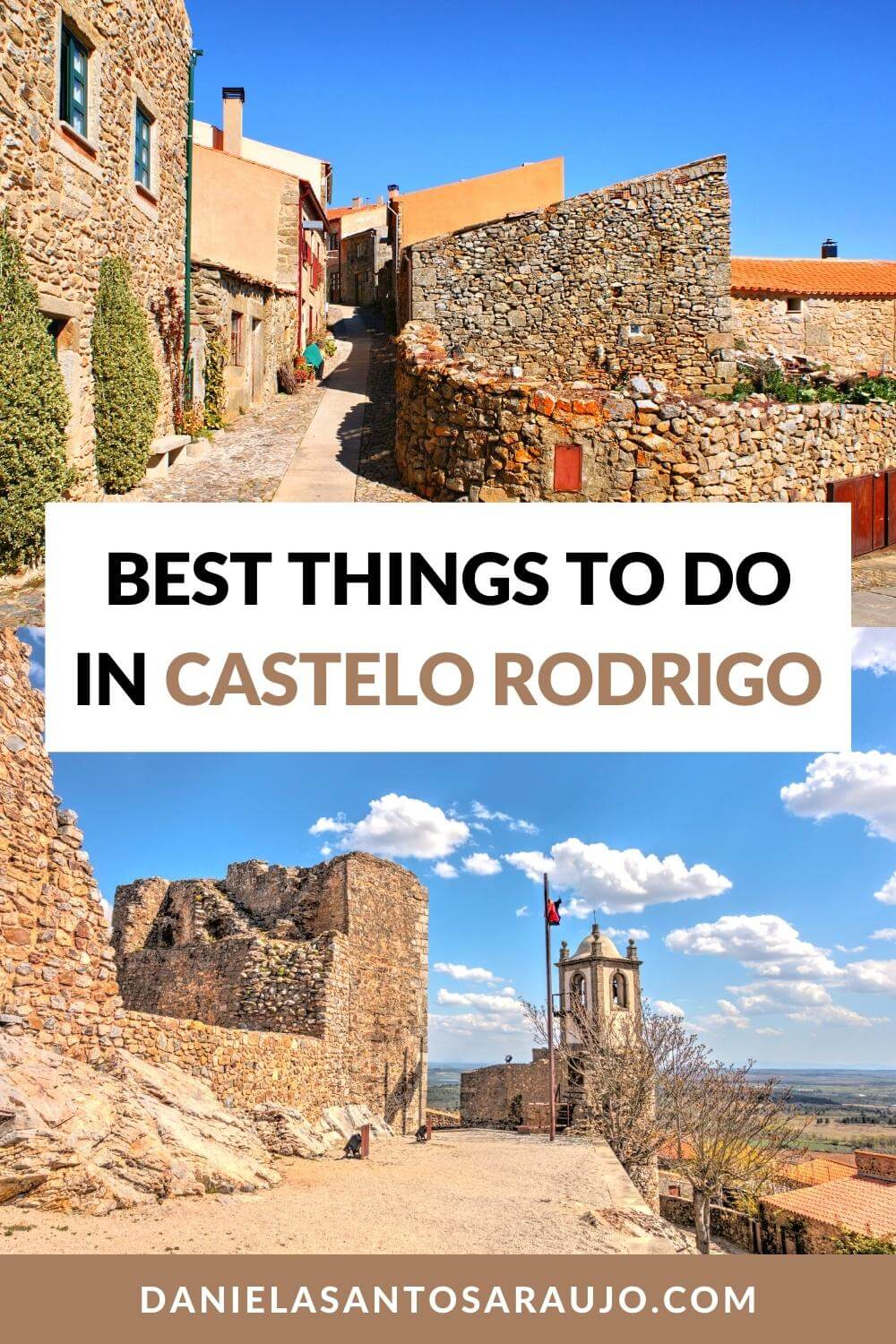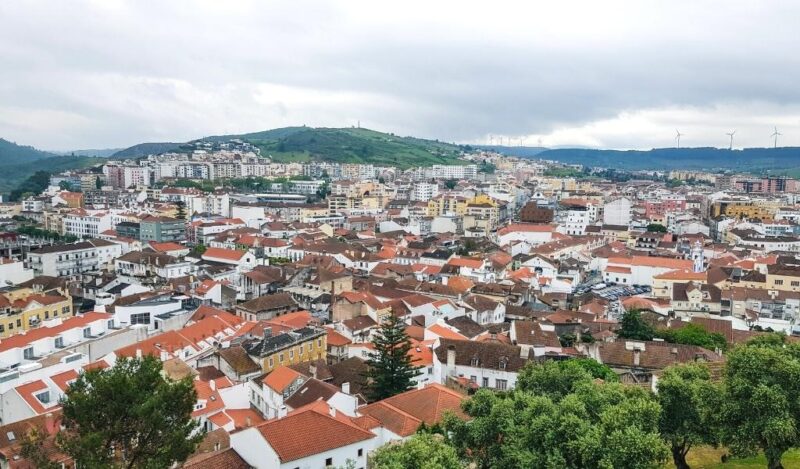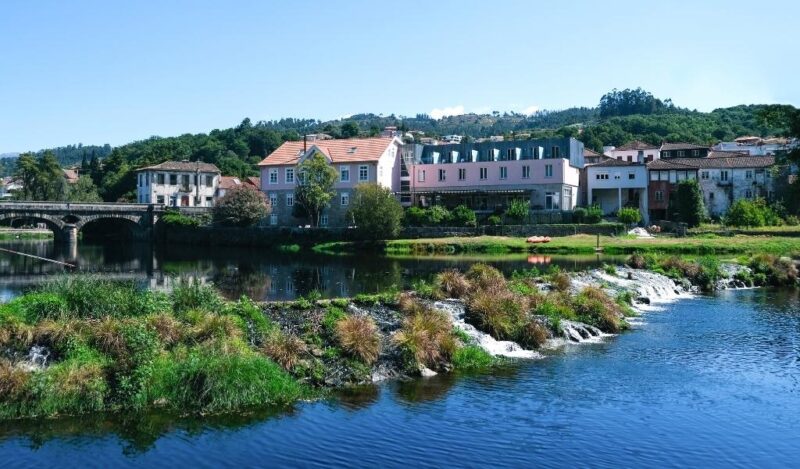The town of Castelo Rodrigo belongs to the municipality of Figueira de Castelo Rodrigo, in the Guarda district. Besides, it’s one of the “12 Historical Villages of Portugal” (a program created by the Portuguese government in 1991, to restore and enhance a series of villages in the Beira Interior region, older than the country itself).
In the Middle Ages, Castelo Rodrigo integrated Portugal’s border defense line and had a wall supported by 13 turrets! Nowadays, only a few of those defensive structures remain, but the ruins are true panoramic viewpoints of the town of Figueira de Castelo Rodrigo and the Serra da Marofa!
So, do you want to know more about 1 Day In Castelo Rodrigo: The Perfect Castelo Rodrigo Itinerary? Keep reading!
This post may contain affiliate links, meaning I earn a small commission if you make a purchase, at no additional cost to you. Please read my disclosure & privacy policy for more information.
No time to read now? Pin it for later!


Brief History of Castelo Rodrigo
Like other historical villages, the area where Castelo Rodrigo is located today was already used for thousands of years, as paleolithic and megalithic remains were found. In fact, the archaeological excavations found not only prehistoric artifacts but also pre-Romans, Romans, and Arabs!
During the Christian Reconquista, Castelo Rodrigo was precisely conquered from the Arabs – but it became a territory of the Kingdom of Léon. The old town only passed to the Portuguese side when King Dinis signed the Treaty of Alcanizes, on September 12th, 1297.

In the 14th century, the historical village of Castelo Rodrigo was repopulated and its castle was rebuilt, taking advantage of the Arab foundations of the Alcazaba. However, the so-called Philippine Dynasty transformed the town into a Spanish Marquessate, managed by Cristóvão de Moura (the viceroy of Portugal).
After having been the scene of several conflicts and invasions during the War of Restoration (1640-1668), Castelo Rodrigo began to lose importance in the panorama of territorial administration and ended up becoming a parish in the newly created municipality of Figueira de Castelo Rodrigo, in the reign of Queen Maria II.
Visiting Castelo Rodrigo
If you’re thinking of visiting the 12 Historical Villages of Portugal on the same trip – that’s exactly what I did – you can combine a day to explore Castelo Rodrigo, Almeida, and Castelo Mendo. Almeida is just over 20 km (south) from Castelo Rodrigo and Castelo Mendo is about 45 km (further south).
Honestly, some of the 12 Historical Villages of Portugal can be visited in one morning or afternoon, as is the case of Castelo Mendo, Idanha-a-Velha, Linhares da Beira, Marialva, Piódão, or Sortelha. As for the others, it depends on the number of monuments you want to include in your itinerary.
Since Almeida, Belmonte, Castelo Novo, Castelo Rodrigo, and Monsanto are towns, it’s likely that you’ll need a day (or two) to explore them from one end to the other. And the same happens with Trancoso, which is a city. By the way, here’s the list of the 12 Historical Villages of Portugal:
- Almeida, in the Guarda district
- Belmonte, in the Castelo Branco district
- Castelo Mendo, in the Guarda district
- Castelo Novo, in the Castelo Branco district
- Castelo Rodrigo, in the Guarda district
- Idanha-a-Velha, in the Castelo Branco district
- Linhares da Beira (or simply Linhares), in the Guarda district
- Marialva, in the Guarda district
- Monsanto, in the Castelo Branco district
- Piódão, in the Coimbra district
- Sortelha, in the Guarda district
- Trancoso, in the Guarda district
Castelo Rodrigo Itinerary
Sun Gate (or Eastern Gate)
The Sun Gate (also called Eastern Gate, because of its east-facing orientation) is the best-known entrance to Castelo Rodrigo. At the time when the historical village was completely surrounded by a wall, this was one of its three entrances.

With a medieval construction, the Sun Gate has direct views of the Spanish border – which justifies its location at this strategic point. From here you can also see the town of Figueira de Castelo Rodrigo (to the left) and the Monastery of Santa Maria de Aguiar (to the right).
Clock Tower
When King Dinis took possession of Castelo Rodrigo and decided to recover his castle, it gained a Barbican – a wall before the walls, which allowed for more effective defense of the fortress. Well, the Clock Tower is located in one of the turrets of this same Barbican, a few meters from the Monumental Palace Gate.

But, you’re probably wondering: “Clock Tower? You don’t mean… Bell Tower?” Yes, the truth is that this Clock Tower works like a Bell Tower these days. But historians have discovered that in the Middle Ages, the tower had a hammer clock, which worked with granite weights!
Castle of Castelo Rodrigo
The Castle of Castle Rodrigo is the heart of this small historical village – I mean, it even gives it its name – and has several points of interest to discover. So, start by entering the Tourist Office, where you can ask for a map and buy a ticket to the Castle (which costs €1).
Both are open from Monday to Friday, from 9 am to 1 pm and from 2 pm to 5 pm. And in this small, ruined enclosure you’ll find:
- Cistern
- Cristóvão de Moura Palace
- Cross-shaped Embrasures
- Keep
- Monumental Palace Gate
- Traitor’s Gate

As I mentioned earlier, Cristóvão de Moura ruled Castelo Rodrigo during the Philippine Dynasty and had a palace built on the site of the old Alcazaba, in 1590. However, the building was set on fire by the population after the Restoration of Independence, who saw it as a symbol of Spanish rule.
Pillory

The Pillory of Castelo Rodrigo was erected in the reign of King Manuel I, with the attribution of the charter issued by the monarch in 1508.
It’s an imposing structure, formed by a pedestal with five steps and a column that rises to almost 8 meters in height.
Interestingly, the two lower steps don’t have the same shape as the others (octagonal or circular) and if you see them from other perspectives, it even seems that they are not even part of the Pillory!
At the top, the column is decorated with a cage typical of the Manueline period. The Pillory of Castelo Rodrigo was classified as a National Monument in a decree of 1922, together with the Castle.
Rocamadour Parish Church
The Parish Church of Castelo Rodrigo was founded in the 13th century by the Confraternity of the Friars of Our Lady of Rocamadour, a French religious association that supported pilgrims on their way to Santiago de Compostela – the most important pilgrimage destination in Europe during the Middle Ages.

In architectural terms, the Catholic temple is a mixture of Romanesque and Gothic styles. Even so, it was the target of profound interventions over the centuries, as evidenced by the Renaissance granite pulpit, the Baroque coffered wood ceiling, and the Rococo altarpiece in gilded woodcarving.
Cistern
While the Castle’s Cistern provided water to the military fortress, the population of Castelo Rodrigo depended on another Cistern located in the center of the town, with a depth of 13 meters and two entrances (one in Gothic style and the other in Arabic style). But this one wasn’t always a water reservoir…

Before King Manuel I signed the edict of expulsion of the Jews (or their forced conversion to Christianity) on December 5th, 1496, Castelo Rodrigo had a Jewish community with its own Synagogue and Mikveh (a place for purification baths). In other words, each door would give access to each place!
Monument to the Restoration
The Monument to the Restoration of Castelo Rodrigo is very similar to the Cross of Castelo Novo, as it was also placed in 1940 to commemorate the 300 Years of the Restoration of Independence (which took place on December 1st, 1640).
I’ve already mentioned the active role played by Castelo Rodrigo in the Restoration War and the Monument with the same name also intends to evoke two other crucial dates in the history of the small town.
One is the Siege commanded by the Duke of Osuna (on June 25th, 1664) and the other is the subsequent Battle of the Salgadela after this invasion (on July 7th, 1664).

Map of the Castelo Rodrigo Itinerary
Share this blog post on your social media!
More Posts about Portugal
4 Best Monasteries In Portugal (That You Should Visit This Year)
5 Best Palaces In Sintra (That You Should Visit This Year)
1 Day In Penafiel: The Perfect Penafiel Itinerary
More Posts about Travel Itineraries
1 Day In Penafiel: The Perfect Penafiel Itinerary
1 Day In Torres Vedras: The Perfect Torres Vedras Itinerary
2 Days In Arcos De Valdevez: The Perfect Arcos De Valdevez Itinerary
What Photography Gear Do I Use?
- Camera Body: Fujifilm X-T4 Mirrorless
- Camera Lens: Fujinon XF 18-55 mm F2.8-4 R LM OIS
- Tripod: Manfrotto Compact Action
- Small Tripod: Manfrotto PIXI Mini
- Smartphone Adaptor: Manfrotto PIXI Clamp
- Memory Card: SanDisk 128GB Extreme PRO SDXC





